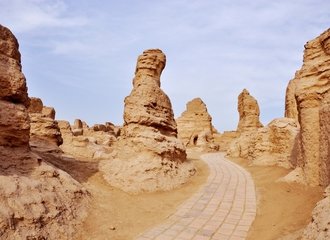Galden Jampaling Monastery

Brief Introduction
Galden Jampaling Monastery, is the largest Gelugpa Sect monastery in Tibetan Buddhism in the Kham area, lying at the junction of Angqu River and Zaqu River in Chamdo with beautiful surroundings. The main deity enshrined here is Byams-pa (Maitreya), hence the name. In 1373, when Tsongkhapa passed by this beautiful place where Angqu River and Zaqu River meet in Chamdo on his way from Qinghai to Tibet, he predicted that it would be an ideal place to build a monastery. In 1437, one of his disciples, Sherab Zangpo advocated the construction of a temple here. After 8 years’ effort, the construction of Galden Jampaling monastery was finished in 1444. However, alongside its main hall and 2 other buildings, the rest buildings of this complex were damaged in 1912 but restored in 1917.
In history, there were five living Buddha lineages, 12 dratsangs in this monastery. It is one of the largest monasteries with the most monks in Tibet as well. According to the rules of the Gelugpa sect, it can house 2,500 monks. At its golden age, it housed a maximum of 5,000 monks and had jurisdiction over 70 small temples nearby. Currently, it is home to over 1,000 monks.

The present construction scale of Galden Jampaling Monastery ranks the first in the Kham area. It occupies an area of 2,023,500 square meters. It has a Main Assembly Hall, a Guardian Hall, two Tara Halls, a Sutra Debating Hall, official residences to its five living Buddhas, nine large dratsangs, eight Zen academies as well as more than twenty sutra chanting halls, one Sutra Printing house and lots of monks dormitory.
It had usually kept a close relationship with past Chinese governments. Since the reign of Emperor Kangxi of the Qing Dynasty (1644-1911), the living Buddhas here have been all conferred by the central government. Nowadays, there is a bronze seal, a plaque inscribed with 'Gandan Jampaling Monastery' granted by Emperor Kangxi and another plaque bestowed by Emperor Qianlong still preserved here.

What to see
The main buildings of Galden Jampaling Monastery have been well preserved. There are tens of thousands of Buddhas’ statues, cultural relics, and Tibetan Studies and Sutras collected here. At its main assembly hall, you can see hundreds of statues of various Buddhas and eminent monks, thousands of square meters of murals, and many magnificent Thangkas, which represent the highest artistic level in Kham.
Pilgrims continuously circumambulate the exterior of the walled complex in the mornings and it's worth following them on at least one circuit. Behind the monastery, to the north of town, trails lead up to a sky burial site. The steep paved road up to the east gate, lined with Tibetan houses, tailors, and prayer-wheel repair workshops, is one of the town’s most interesting roads to walk.
The monastery is on a hilltop. Enter it from the east side and a paved road leads up from the town below. Visit the impressive Tseni Dukhang and the old Khampa weaponry. Back outside, the monastery's enormous kitchen is well worth a look, but only men can go inside. And the main assembly hall dukhang is particularly impressive, especially when it is packed with hundreds of murmuring monks.

Festivals
The most famous feature of the monastery is its religious Holy Dance, which is mainly composed of ‘Guqing’ holy cham dance featured with non-mannerism postures, grant scenes, and dancers wearing ferocious and living masks and ‘Yue’ (ax) dance characterized with gorgeous costumes and elegant postures. It is only performed during the Butter Lamp Festival to commemorate the victory of Sakyamuni against the heretics in a religious debate. The festival falls on the 15th day of the first month of the Tibetan calendar. During the festival, the monks will wear masks and perform this holy dance to drive off the ghosts and to pray for a good harvest the year coming.
The grand festival for inviting Byams-pa of Jampaling Monastery, having a history of over 500 years, is on the 15th day of the 2nd Tibet lunar month (someday of March to April in Gregorian calendar). During the festival, there will be two activities: one is the unfurling of an 18 meters high and 13 meters wide Thangka painting bearing the image of Byams-pa and exhibiting a 2-meter-high statue of Byams-pa; the other is a pilgrimage. On this day, thousands of monks from the whole monastery chant together and tens of thousands of followers come to show their worship to Byams-pa.

Useful Travel Tips
- It is open during the whole day, but some chapels close at 16:00pm. There is no admission fee to enter Jampaling Monastery.
- It is suitable for traveling there all year round, but the best time to visit is from June to September as it is with the best scenery and warmest weather during this period.
- To reach Galden Jampaling Monastery, you need to reach Chamdo by land or by air first. If by land, from Lhasa, it is about 1,100KM via Nyingchi, about 900KM via Nagqu; it is about 1,200KM no matter from Chengdu or Kunming. If by air, there are airlines from Lhasa, Chengdu, Chongqing, Xi’an, Shenzhen, Tianjin to Chamdo Bangda Airport.





















